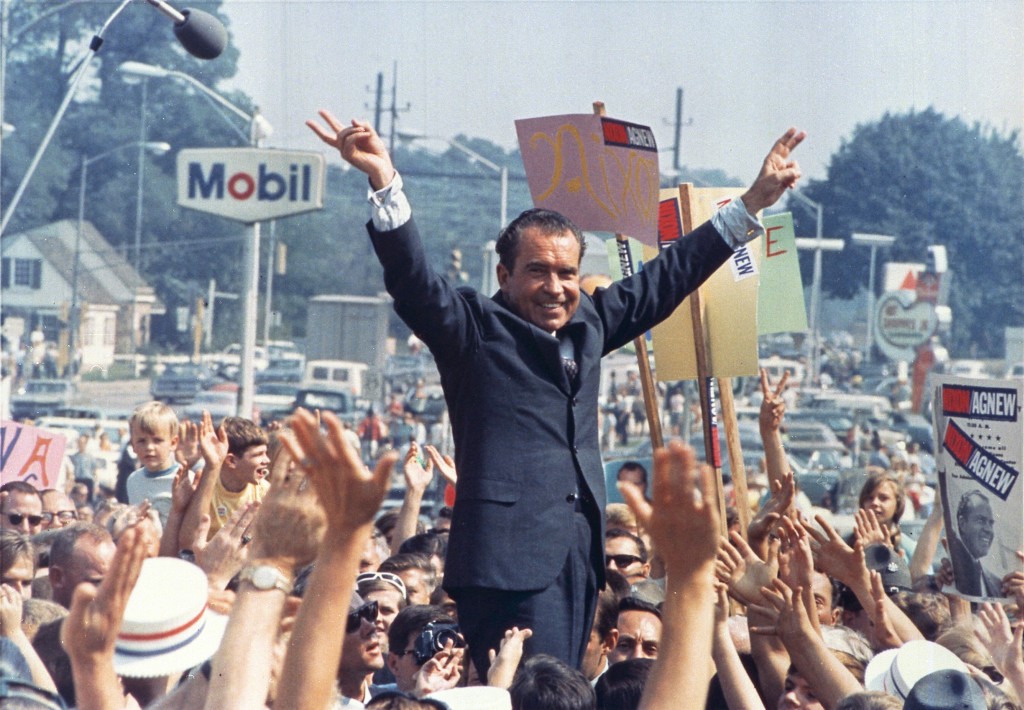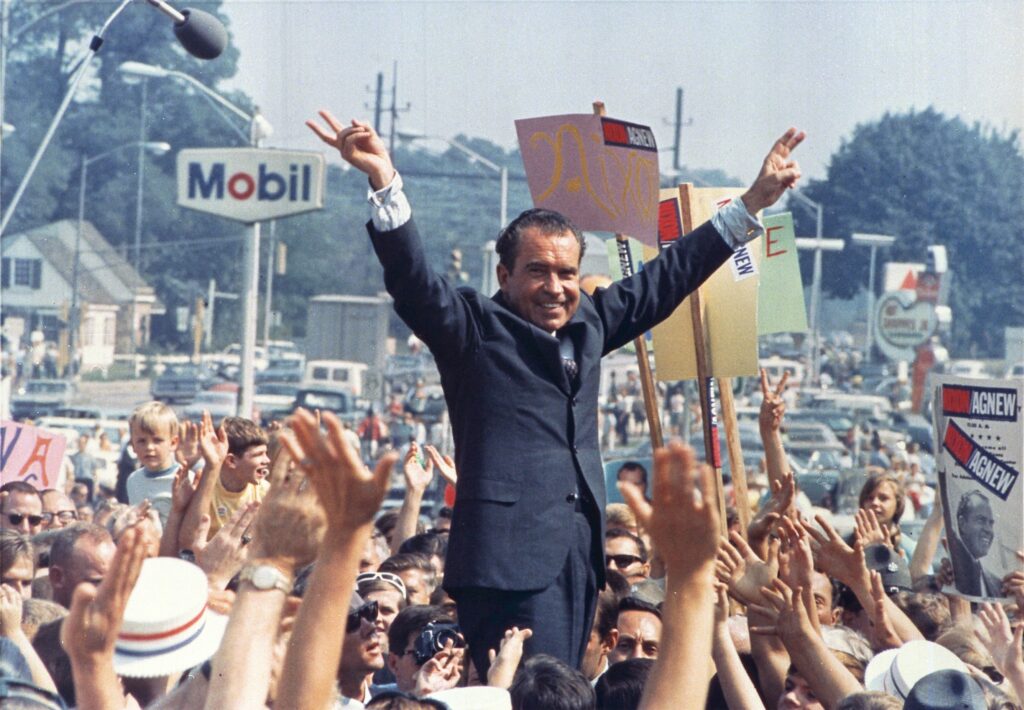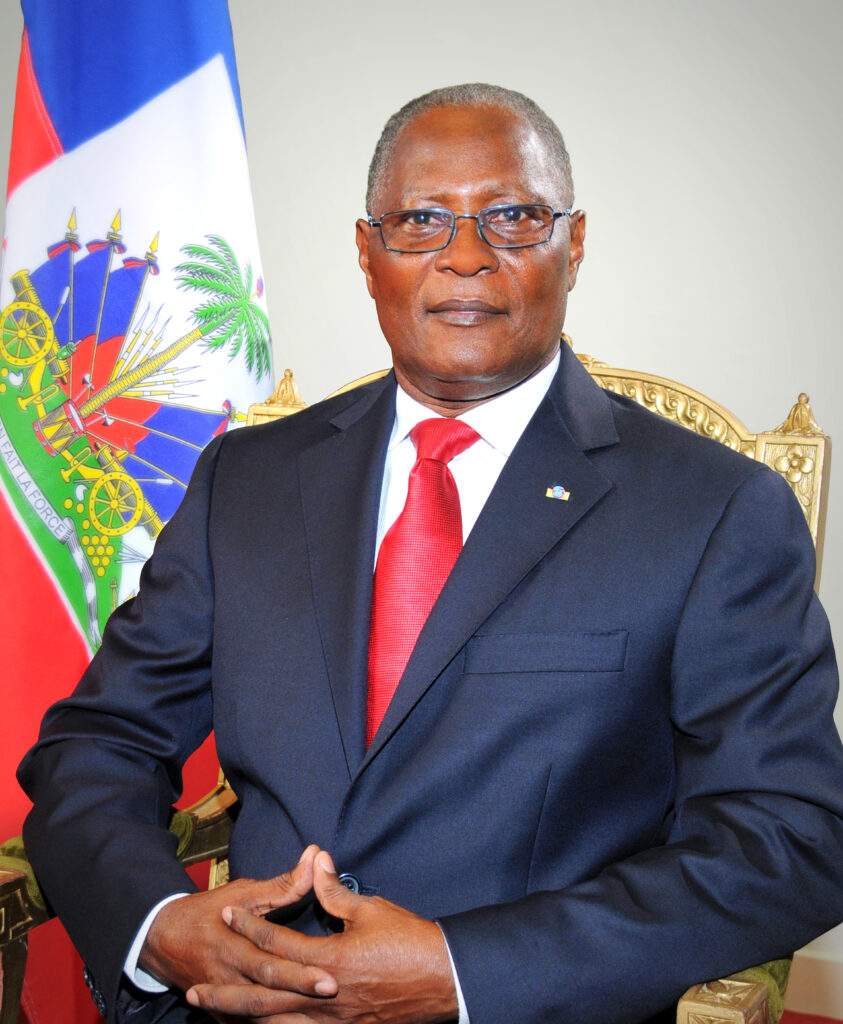
I- NIXON’S WORLD AND OURS
Most readers will be familiar with the not-often-observed legal responsibility of the President of the United States to provide Congress with an annual report on his administration’s foreign policy initiatives, called the “National Security Strategy.” Though the annual NSS requirement was not put into law until the Goldwater-Nichols Act of 1982, the concept was inspired by President Nixon and Henry Kissinger’s publication of four “Annual Reports to the Congress on United States Foreign Policy,” published in 1970, 1971, 1972, and 1973 as the public articulation of the Nixon Administration’s overall strategic approach.
These four NSS prototypes surpass most of their legally-mandated descendants in conceptual solidarity, owing, perhaps, to the genius of Nixon-Kissinger duo and their staff, and to the lack of State Department and Defense Department meddling with the editing and publication processes. Most importantly, the first two reports open up with incredibly detailed analyses of the trends leading up to the 1970s, hinting towards necessary conceptual changes in American strategy. The second two reports, published during and after the administration’s great strategic successes in China, Vietnam, the Soviet Union, and the Middle East, document the administration’s practical application of the conceptual principles articulated in the first two reports.
It’s helpful to revisit the openings of the first two reports, if only to observe the parallels between Nixon’s time and ours. First we will look at the changes Nixon responded to- then we’ll look at the changes to which we in 2017 must respond.
To quote the first report at length, then, on international developments between 1945 and 1970:
“The postwar period in international relations has ended…
[When President Harry S. Truman adapted and implemented the Containment doctrine as U.S. strategy,] we were the only great power whose economy and society had escaped WWII’s massive destruction. Today, the ravages of that war have been overcome. Western Europe and Japan have recovered their economic strength, their political vitality, and their national self-confidence…
Then, new nations were being born, often in turmoil and uncertainty. Today, these nations have a new spirit and a growing strength of independence…
Then, we were confronted by a monolithic Communist world. Today, the nature of that world has changed- the power of individual Communist nations has grown, but international Communist unity has been shattered…
Then, the United States had a monopoly or an overwhelming superiority of nuclear weapons. Today, a revolution in the technology of war has altered the nature of the military balance of power…
Then, the slogans formed in the past century were the ideological accessories of the intellectual debate. Today, the “isms” have lost their vitality…”
Or, more succinctly, in the second report:
“We are at the end of an era. The postwar order in international relations- the configuration of power that emerged from the Second World War- is gone.”
A similarly tectonic series of shifts has happened in the Post-Cold War world, with the breaking point being effectively somewhere between 2014’s Russian annexation of Crimea and the rise of the ISIS Caliphate. The crumbling of the old era is in our instance, though, perhaps more fundamental and shocking even than it was in Nixon’s time. A similar autopsy of the Post-Cold War world today might read something like this:
“The Post-Cold War period in international relations is over.
When President George H.W. Bush declared a “New World Order,” America was victorious in the bloodless end of the Cold War, and proudly stood tall as the unquestioned leader of the nations of the Earth. Today, America is exhausted, divided, and unsure of its basic purpose in world leadership, even unsure of the reason behind its own political existence….
Then, there were no significant ideological challengers to Western liberal democratic capitalism. Today, various brands of authoritarianism have returned from history and brought their own conceptions of order to the world stage….
Then, no regional great powers threatened the stability of the international system. Today, ascendant great powers in every strategic theater of Eurasia seek to implement new regional orders of their own making….
Then, the processes of globalization, liberalization, and democratization seemed inexorable and inevitable, as nation after nation underwent peaceful revolutionary transitions and joined the liberal international order. Today, all those trends have been reversed- peoples around the world reject globalization, and more of them live under autocratic or semi-autocratic rule than at any other time since the end of the Cold War….
Then, the threat of geographic anarchy and mass-casualty terrorism seemed real, but manageable. Today, whole swathes of the Middle East and Asia have descended into chaos, and fundamentalist terrorists strike out at publics around the world on a regular basis.
We are at the end of an era. The Post-Cold War order in international relations- the order that emerged from the Cold War- is gone.”
Clearly, a new strategic grand design, set forth in this new era, is crucial.
II- PRINCIPLES, CONDUCT, AND LEGACY OF THE NIXON DOCTRINE
President Nixon aspired to be a “peacemaker,” if his first inaugural address is to be taken at its word- “The greatest title history can bestow is “peacemaker.”” Nixon’s vision of peace was far more sophisticated than that of some of his opponents- “Peace must provide a durable structure of international relationships which inhibits or removes the causes of war… Within such a structure, international disputes can be settled and clashes contained… the habits of moderation and compromise will be nurtured…”
It’s reasonable to assume that Nixon was enough of a political realist to know, with that other great realist Alexander Hamilton, that “the seeds of war are sown thickly in the human breast,” and contrary to liberal internationalist dreams, cannot ever be fully removed through institutions, in the interests of perpetual peace. That said, Nixon was certainly enough of an internationalist to know that the causes of war could be inhibited and constrained through institutional arrangements- the balancing of power against power, the formalization of dispute resolution, and all the rest.
Moving the international system towards such a practical, if perhaps temporary, vision and reality of peace, stewarded by American leadership, was what the Nixon Doctrine was all about.
As outlined in the first section of the first Annual Report, and extrapolated in the first sections of the subsequent three Annual Reports, there were three primary intellectual components to the Nixon Administration’s strategic approach: “Peace Through Partnership,” “America’s Strength,” and “Willingness to Negotiate.” Taken together, these constitute the Nixon Doctrine in the broadest possible use of that term.
PEACE THROUGH PARTNERSHIP
In the preceding quarter-century to the Nixon Presidency, the modus operandi of American foreign policy generally featured American involvement and direct American action wherever national interests and world order were threatened. This resulted in exceedingly expensive international commitments, in all senses- diplomatic capital, money, manpower, and oftentimes blood. It was not a particularly efficient way of carrying out policy, and often had the unfortunate side-effect of disillusioning the American public, as the Vietnam War scenario demonstrates.
Nixon’s response, similar to his mentor President Eisenhower’s, was to level the playing field of contributions in America’s alliances in order to reduce American expenditures while deepening American partnerships. This is not dissimilar to President Obama’s and President Trump’s insistence that NATO allies, Japan, and South Korea “pay their fair share” in defense spending, though it is not clear that Trump and Obama have had the deepest of strategic understandings behind their similar policies.
In direct contradiction to President John F. Kennedy’s “Bear any Burden, Pay any Price, for the Survival and Success of Liberty” promise, President Nixon declared a humbler and more partnership-oriented U.S. strategy his administration would pursue:
“…the United States will participate in the defense and development of allies and friends, but… America cannot- and will not- conceive all the plans, design all the programs, execute all the decisions, and undertake all the defense of the free nations of the world. We will help where it makes a real difference and is considered in our interest.
America cannot live in isolation if it expects to live in peace. We have no intention of withdrawing from the world. The only issue before us is how we can be most effective in meeting our responsibilities, protecting our interests, and thereby building peace.
A more responsible participation by our foreign friends in their own defense and progress means a more effective common effort towards the goals we all seek….”
Although on the surface a cost-saving measure, the Partnership aspect of the Nixon Doctrine played a large role in Nixon and Kissinger’s vision of a peaceful international system, as well. By involving more nations in their own defense and development programs, and allowing them to take greater roles in their partnerships with the United States, American policy would increase the stake each partner nation had in the stability and continuity of the international system.
This same principle informed at least two other major components of the Nixon Doctrine- first, the invitations to isolated nations like China to join the international community, in the assumption that making former rogue states into minor stakeholders would pave the way to those states gradually assuming more productive and responsible stakeholder roles in the international system. Second, the concept of diplomatic “linkage” in negotiations- the idea that if states cooperated in multiple sectors and issue areas, misbehaving states could be induced to cooperate further with America by if pressure was applied to them on particular issue areas and if positive incentives were linked to good behavior across the board.
The harmony between the goals of lessening American commitments and increasing allied stakeholder participation in alliances, to be achieved by American retrenchment of funding and allied increase of funding, was in some ways a miracle- one of the great tricks of public policy is aligning gimmicks to build up programs that accomplish multiple beneficial goals, while minimizing the consequences and tradeoffs. The Nixon Doctrine’s emphasis on partnership in the dual interests of decreased U.S. expenditures and greater allied participation in the international system exemplifies that trick beautifully.
AMERICA’S STRENGTH
President Nixon increased and reformed the defense budget, focusing on upgrades to America’s strategic nuclear forces and naval and air platforms in the interests of modernization. The Administration also began investing in various technological advances to change the game of warfighting, specifically in the fields of stealth and precision munitions. These advances were not a luxury- it was a perceived necessity, given the recent attainment of Soviet nuclear parity and the USSR’s general increases in military spending and military activity.
The comprehensive reforms to the defense budget and defense planning system were accompanied by arms negotiations with the Soviets, to reduce global stockpiles of nuclear weapons in a bid to realign defense postures and reduce military tensions.
Nixon never approached the “Peace Through Strength” question quite the way President Ronald Reagan would, whose approach emphasized ultimate military superiority. Nixonian military planning and arms control, rather, assumed general equality of capabilities between nations, and sought to use other diplomatic methods to maximize the American position by reducing overall stockpiles. But it nonetheless was a realization that America needed a certain relative power position to other great powers that needed to be, if perhaps not superior to the capabilities of the USSR and others, at the very least equal and advantaged. It was strength in a relative rather than absolute sense.
WILLINGNESS TO NEGOTIATE
Finally, (and this is what the Nixon Doctrine is perhaps most famous for,) Nixon and Kissinger made a strong point to emphasize improving relationships with hostile adversaries and great powers. This particularly pertained to the opening to China and the negotiations with the Soviet Union, gestures of openness and goodwill accompanied by firmness and resolve.
Nixon and Kissinger believed, and Nixon often wrote, that the permanent exclusion of any society from the life of the international community was likely to make that society more radical; whereas the inclusion of that society could have a tempering effect on its behavior, and even begin the process of transforming that society into a responsible stakeholder. They were under no illusions about the prospect of changing hearts and the human condition or ending warfare permanently, but they did have a certain faith in the prospects of international order conducted through institutionalized avenues of communication between the great powers.
For this reason, the Nixon Doctrine emphasized cooperation with the USSR and PRC on as many noncontroversial and non-conflicting issues as possible, under the belief that fruitful partnerships in some areas would be useful as a general relationship-improving device in international affairs. Used with greater sophistication, this became the policy of linkage- pressure would be applied on lesser areas like economic development and scientific cooperation to influence foreign leaders’ decision-making on higher areas of statecraft like diplomatic openings and arms control.

These three elements of the Nixon Doctrine’s intellectual articulation- Peace Through Partnership, America’s Strength, and Willingness to Negotiate- provided intellectual backdrop for one of the most sophisticated applied grand strategies of the 20th Century. The big takeaway from this information should be that the Nixon grand strategy was not solely about cold, cynical, Machiavellian balancing of power and calculation of interest- there was an incredibly significant faith in institutions and cooperation, as well.
But there was much more to the story than the three intellectual components of the Nixon Doctrine alone.
THE CONDUCT OF THE NIXON DOCTRINE
These three principles of the Nixon Doctrine were, of course, chiefly the Administration’s public articulation of its actual activities and intentions. The reports outlined the thinking and public image of the Nixon Doctrine, but deeper investigation is necessary to assess its actual conduct and legacy.
Fortunately, the foreign policy scholar Dan Caldwell did exactly that in his essay “The Policies of Henry Kissinger.” Caldwell argues that Nixon and Kissinger generally devised a “Grand Design” of the world they wanted to build, and a “Grand Strategy” to attain it and manage it. The relevant passage, a listing of principles, is copied below:
Grand Design:
- Accept the emergence of a tripolar configuration of power in the security issue area and a multipolar international economic system.
- Encourage the development of a moderate international system supported by the U.S., the U.S.S.R., and the P.R.C.
- Stop the spread of Communism to areas of the world in the traditional Western sphere of influence, but avoid direct military confrontation with the U.S.S.R.
Grand Strategy:
- Accept Soviet achievement of nuclear parity; strive for the limitation of strategic arms (SALT.)
- Contain the spread of Communism through: a) deterrence of military aggression [Europe]; b) the use of positive incentives [China]; c) mixed strategies employing positive incentives and negative sanctions [Vietnam]; and d) covert operations (Chile.)
- Maintain firm collective security arrangements with the NATO Alliance and Japan; other alliance commitments should be more flexible; all allies should pay a greater proportion of the cost of defense as well as provide manpower (Nixon Doctrine.)
- Deal with tension between Grand Design objectives of containing Communism to traditionally Western areas and avoiding direct military confrontation with the U.S.S.R. through communication and consultation with the U.S.S.R.; threaten or use U.S. force only if absolutely necessary.
- Employ careful, presidentially-controlled crisis management of confrontations and limited wars to prevent escalation; communicate and consult with other relevant great powers in crisis situations (Basic Principles and Agreement on the Prevention of Nuclear War.) [Yom Kippur War crisis, “Shuttle Diplomacy.”]
- Recognize the boundaries of post-World War II European states and the Soviet sphere of influences in Eastern Europe, while attempting to encourage freer interchange between Eastern and Western Europe (Helsinki Agreement.)
- Encourage ties between the U.S. and Soviet Union through the conclusion of a number of cooperative projects in the economic, cultural, scientific and technological areas. [Ping-Pong Diplomacy, international elements of the Space Shuttle program.]
- Develop regimes (agreed rules, procedures, and institutions) in important issue areas.
- Attempt to mesh the various regimes into an overall grand strategy; use asymmetrical advantage in one regime to influence other issue areas [linkage doctrine.]
- Maintain U.S. foreign policy commitments with reduced public and Congressional support.
As Caldwell very clearly demonstrates, the Nixon Doctrine had very concrete objectives and methods attached to its three general principles. It also was very well aware of the context of America in the 1970s- exhaustion, relative decline amid a “rise of the rest,” reduced resources, and a worsening international environment under the nuclear specter of the Cold War.
Contrary to the common public memory of the Nixon years, the opening to China and the extrication from Vietnam were not done chiefly for their own sake- they were done in the broader context of a global grand strategy that ultimately centered on competing with the Soviets in the Cold War on terms more amenable to American interests and limited American resources.
THE LEGACY OF THE NIXON DOCTRINE
The legacy of the Nixon Doctrine in its own time was mixed- as Caldwell notes, many of the doctrine’s institutions broke down by 1976, and such trends of the late 1970s as the Communist expansions into Angola, South Vietnam, and other areas, as well as generally increased Soviet military activity, seem to imply that Nixon and Kissinger failed to institutionalize the “lasting structure of peace” the President so hoped to build through his diplomacy.
But in a broader sense, Nixon really did set up the contours of the Post-Cold War world in more ways than one. The realignment of diplomacy towards China and East Asia more generally did not, perhaps, create the “tripolar world” of Kissinger’s hopes; but it did produce a necessary adjustment in American diplomatic focus as the East Asian economies grew into global power players. The rules and regimes and programs set up were generally not new, as the internationalists of the preceding four decades or so had already dreamt them up. But Nixon, more than Kennedy and Johnson before him, figured out how to use such instruments, through the linkage doctrine, in broader diplomatic efforts- a feat that has not adequately been imitated by any President since.
If anything, Nixon’s strategy for peace was timely, but his structure of peace was built too early- it better fitted a Post-Soviet world. The strategy and structure nonetheless were well-adapted for the American and international situation of the early 1970s, and provide a good model for our similar world of the late 2010s.
There remains the question of the legacy of the Nixon Doctrine throughout the remainder of the Cold War. Generally, President Gerald Ford imperfectly continued the Nixon Doctrine, particularly with Henry Kissinger as his Secretary of State, while President Jimmy Carter wholly rejected the Nixon Doctrine for a human rights-focused approach. But more interesting is the relationship between the Nixon Doctrine and the final phase of the Cold War- the Reagan years.
Some historians, like John Lamberton Harper, have argued that Nixon’s grand strategy was really a “holding action” in the Cold War- a reluctant acknowledgment of temporary American weakness, meant to hold the international order in place while new sources of American strength could be built up, all the while vowing an eventual return to Containment or even Rollback and a “policy of victory” in the Cold War against the Soviet Union.
These historians point to Nixon’s support and advising of Ronald Reagan throughout the eight years of the Reagan Presidency, as evidence of Nixon’s supposed shared belief that the United States had to defeat the U.S.S.R. and eventually would do so through aggressive and active foreign policy.
This seems to me to be misguided.
First off, Nixon, like Kissinger, seems to have believed that American preeminence was over. Perhaps this was a mistaken assumption, given the triumphant roaring-back of the 1990s and 2000s. Nonetheless, a foundational intellectual element of everything Nixon did in foreign policy was the notion that America had to get used to leading the world with prudent statecraft, rather than by sheer mass, money, manpower, and influence. He was no declinist, but sincerely believed in the rise of the rest- including the Soviet Union.
Every policy instrument and strategic doctrine Nixon designed, then, was generally crafted assuming that the risen and forthcoming multipolarity would feature a strong Soviet Union. I don’t think Nixon wanted to destroy or even defeat the U.S.S.R.- in my interpretation, he merely wanted to keep it contained and, perhaps, at most, encourage it to become a more responsible stakeholder, and maybe even reform its domestic institutions a bit.
All this implies that had things gone differently- had Watergate been weathered or had it not happened- the Nixon Doctrine might have been institutionalized and the conservative and neoconservative takeover of the Republican Party might not have subsequently transformed American foreign policy. This in turn would have resulted in a very different endgame for the Cold War, perhaps resulting in a reformed-but-still-formally-Communist Russia not dissimilar to America’s post-1972 relationship with a reformed-but-still-formally-Communist China. But this is all speculative.
Less speculative is the fact that Reagan’s successor, President George H.W. Bush, in many ways refuted not only the rhetoric but the substance of Reagan’s policies. Bush 41 was basically a Nixonian realist in foreign policy, the best example of realist-style statecraft after 1974, better even than Nixon’s own Vice-President, Gerald Ford. President Bush’s National Security Advisor Brent Scowcroft and his Secretary of State James Baker III were similarly-tempered. This trio- again, not dissimilar to the Nixon-Kissinger duo- presided over great historical shifts, very admirably managed the fall of the U.S.S.R. as bloodlessly as possible, and laid down the basic outlines of the “New World Order” of international relations for the 1990s and 2000s. Indeed, it could almost be argued that what Nixon and Kissinger failed to institutionalize by 1974, Bush and Scowcroft and Baker basically brought into practice in 1991.
There’s no way to tell whether or not a second Bush term might have resulted in the further institutionalization of realistic foreign policy-making and a revival of the popularity of the Nixon Doctrine’s spirit; alas, the “New World Order” of President Bush was to be inherited by three far less experienced statesmen over the subsequent two decades, and thus fell a bit more quickly than Truman’s world order of Containment fell.
A version of this essay first appeared at The Hamiltonian Republican.
This is Part I of a two-part series.
Luke Phillips would like to thank Ambassador Winston Lord and Dr. Dan Caldwell for their advice in preparing this essay. But all ideas and assertions made are Phillips’s alone.
The views expressed by the author do not necessarily reflect those of the Glimpse from the Globe staff, editors or governors.










